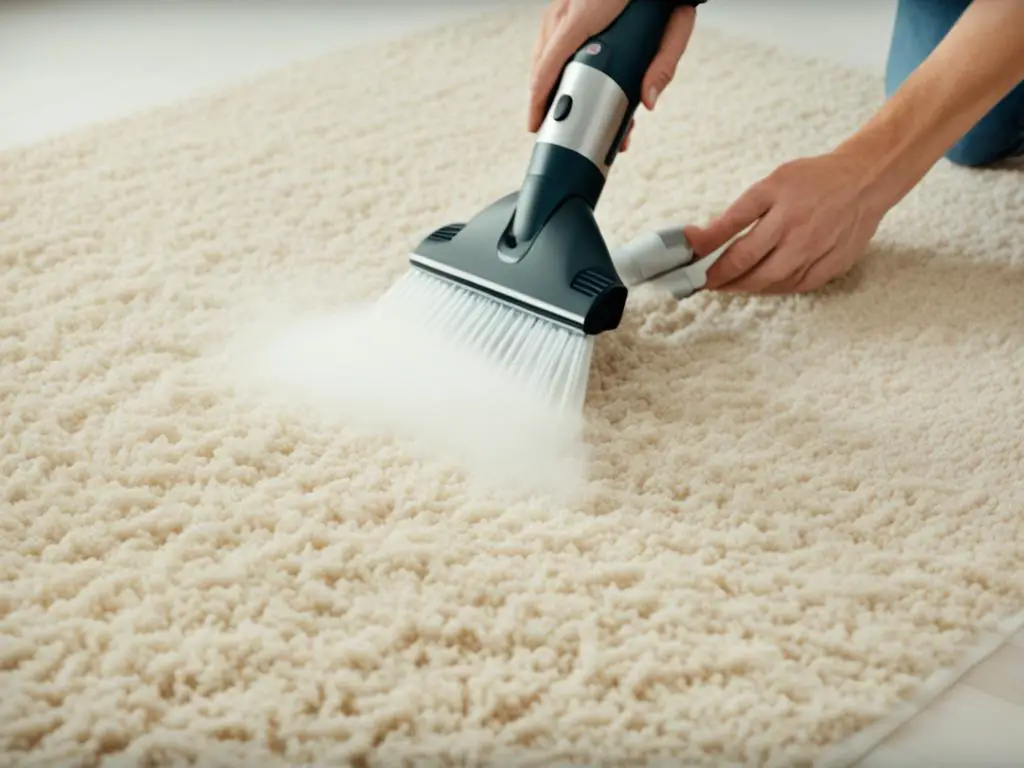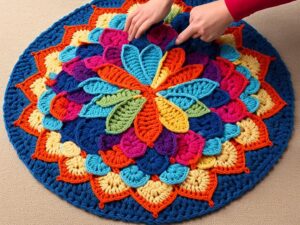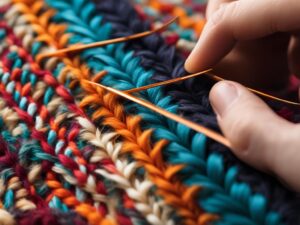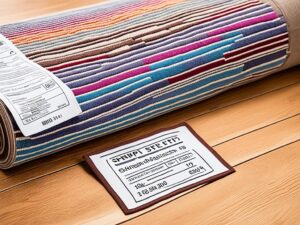If you own a beautiful viscose rug, you know how it can add a touch of elegance and sophistication to any room. However, caring for a viscose rug requires specific attention due to its lower fiber strength and sensitivity to moisture. To help you keep your rug clean and well-maintained, we’ve put together an easy step-by-step guide on how to effectively clean and care for your viscose rug.
Key Takeaways:
- Use gentle cleaning solutions sparingly to avoid discoloration or damage to your viscose rug.
- Act quickly when spot cleaning stains on your rug to prevent them from spreading.
- Avoid excessive moisture and high humidity to prevent fiber discoloration and weakening.
- Rotate your rug and use furniture pads to distribute wear and protect it from marks.
- For deep cleaning, it’s best to rely on professional cleaners who use dry-cleaning methods.
Understanding Viscose Rugs
Viscose rugs are a popular choice for homeowners looking to add a touch of elegance and luxury to their living spaces. These rugs are made from natural fibers obtained from wood, cotton, or bamboo, which are then processed and spun into a rug material that closely resembles the look and feel of silk. With their soft texture and beautiful sheen, viscose rugs can instantly elevate the style of any room.
However, it’s important to note that viscose rugs have specific care requirements due to their lower fiber strength and sensitivity. To ensure that your viscose rug retains its beauty and longevity, it’s crucial to follow proper care guidelines.
What Are Viscose Rugs?
“Viscose rugs are made from natural fibers obtained from wood, cotton, or bamboo, which are then processed and spun into a rug material that closely resembles the look and feel of silk.”
Viscose rugs, also known as art silk or rayon rugs, are known for their lustrous appearance and smooth texture. They are often chosen as a more affordable alternative to silk rugs. Viscose fibers are typically blended with other materials, such as cotton or wool, to enhance their durability and make them suitable for everyday use. The result is a rug that exudes elegance and sophistication.
care requirements for Viscose Rugs
- Avoid Heavy Foot Traffic: Due to their lower fiber strength, viscose rugs are not well-suited for high-traffic areas. Placing them in low-traffic zones or using them as decorative pieces in bedrooms or sitting areas can help prevent excessive wear and tear.
- Gentle Vacuuming: Regular vacuuming is essential for removing dust and debris from your viscose rug. However, it’s important to use a vacuum cleaner with a gentle setting or a non-electric vacuum to avoid pulling on the delicate fibers.
- Spot Cleaning: When it comes to cleaning spills or stains on a viscose rug, it’s important to act quickly. Blot the affected area with a paper towel or a light-colored rag to absorb as much liquid as possible. Avoid using strong cleaners or excessive moisture, as these can cause discoloration or damage. Instead, opt for a mild dish soap or a solution of equal parts white vinegar and water.
- Avoid Direct Sunlight: Prolonged exposure to direct sunlight can cause fading and discoloration of viscose rugs. To maintain their vibrancy, it’s best to place them away from windows or use window treatments to protect them from harmful UV rays.
By following these care requirements and treating your viscose rug with care, you can enjoy its beauty and softness for years to come.
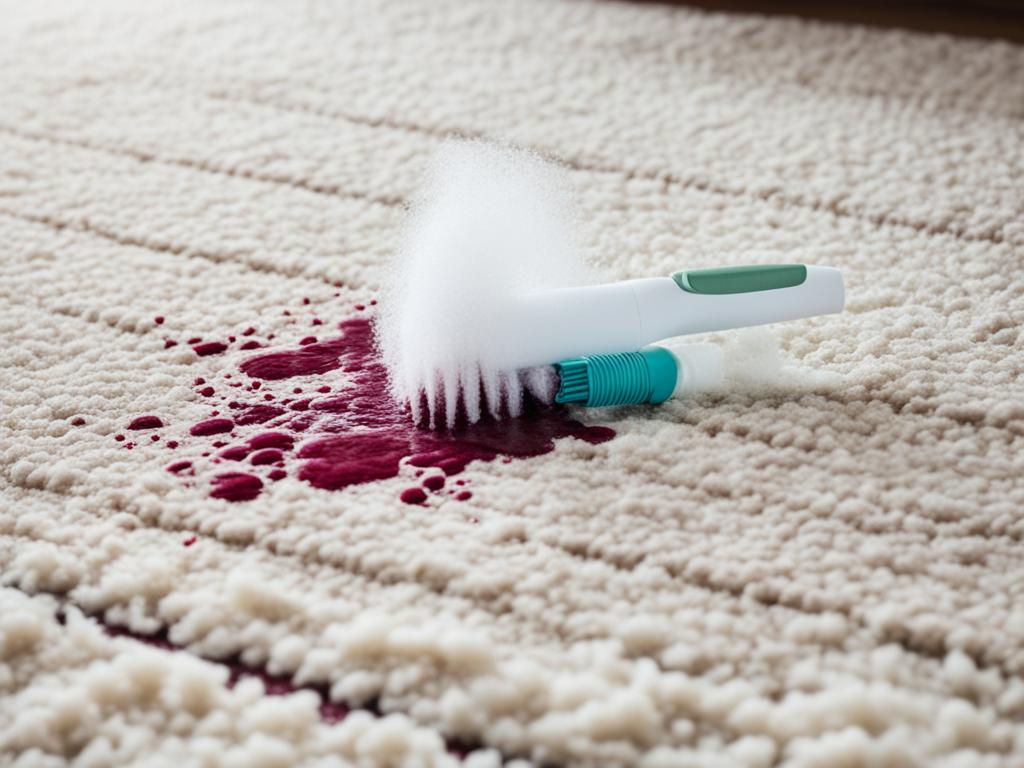
Spot Cleaning a Viscose Rug
When it comes to maintaining the beauty and longevity of your viscose rug, spot cleaning is an essential skill to master. Acting quickly to address stains will not only prevent them from spreading but also protect the delicate fibers from potential damage. Follow these step-by-step instructions to effectively spot clean your viscose rug:
- Blot the stain: Start by blotting the stain with a paper towel or a light-colored rag. This will help to absorb any excess liquid and prevent it from further penetrating the fibers.
- Choose the right cleaning solution: Instead of using water, opt for approved cleaning solutions for viscose rugs. A citric or acetic acid solution, or a mixture of equal parts white vinegar or mild dish soap with cold water, can be effective in removing stains without causing discoloration.
- Apply the solution sparingly: It is crucial to apply the cleaning solution sparingly to avoid oversaturating the rug. Use a clean cloth or sponge to gently dab the stained area, working from the outer edges toward the center. This will prevent the stain from spreading.
- Rinse with cold water: After cleaning, rinse the area with cold water to remove any residue from the cleaning solution. Again, be mindful of not oversaturating the rug. Blot the excess moisture with a dry cloth or paper towel.
- Maintain softness and prevent moisture damage: To maintain the softness of your viscose rug and prevent moisture damage, mist the cleaned area with a fabric softener solution. Dry the rug promptly by using a cool setting hairdryer or allowing it to air dry naturally.
By following these steps, you can effectively spot clean your viscose rug and keep it looking its best. Remember to always test any cleaning solution on a small, inconspicuous area of the rug before applying it to the stained spot.
Example of a Spot Cleaning Solution for Viscose Rugs:
| Cleaning Solution | Description |
|---|---|
| Citric or acetic acid solution | A mixture of citric or acetic acid with cold water can help remove stains without causing discoloration. Dilute the acid with water before applying it to the rug. |
| Mild dish soap and water | A mixture of equal parts mild dish soap and cold water can also be used as a cleaning solution. This gentle solution can effectively remove stains while protecting the delicate fibers of the viscose rug. |
| White vinegar and water | A mixture of equal parts white vinegar and cold water can be an effective cleaning solution for removing stains from viscose rugs. The mild acidity of white vinegar helps break down stains without causing damage. |
Always remember to use approved cleaning solutions and avoid harsh chemicals or excessive moisture when spot cleaning your viscose rug.
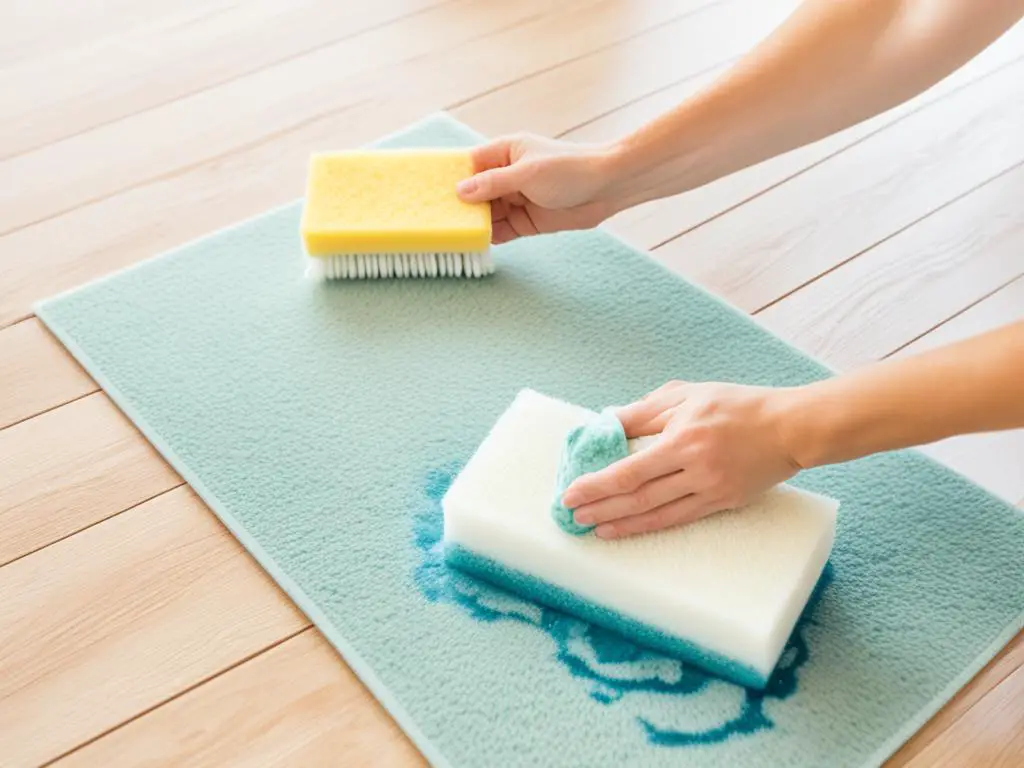
Deep Cleaning a Viscose Rug
While regular spot cleaning can help maintain the appearance of your viscose rug, deep cleaning by a professional is essential every two or three years to ensure thorough maintenance. Professional cleaners have the expertise and specialized equipment to treat viscose rugs effectively.
Professional viscose rug cleaning uses dry-cleaning methods to minimize exposure to moisture and water. This is crucial as excessive moisture can damage the delicate viscose fibers, leading to brittleness and yellowing. By using dry-cleaning techniques, professionals can safely remove deep-set stains while preserving the rug’s integrity.
Unlike other rug materials, like wool or synthetic fibers, steam cleaning is not recommended for viscose rugs due to their sensitivity to moisture. Even a small amount of moisture from steam cleaning can cause irreversible damage and discoloration.
Benefits of Professional Viscose Rug Cleaning
- Professional cleaners have in-depth knowledge of viscose rugs and their specific cleaning requirements.
- Dry-cleaning methods effectively remove deep-set stains without compromising the rug’s fibers.
- Expert cleaning techniques ensure the longevity of your viscose rug by avoiding moisture-related damage.
By entrusting your viscose rug to a professional cleaner, you can ensure that it receives the appropriate care and attention it needs for deep cleaning.
| Viscose Rug Deep Cleaning Checklist: |
|---|
| 1. Research and find a reputable professional rug cleaner specializing in viscose rugs. |
| 2. Inquire about their cleaning methods and ensure they use dry-cleaning techniques. |
| 3. Schedule an appointment for deep cleaning every two or three years. |
| 4. Communicate any specific concerns or stains that need attention during the cleaning process. |
| 5. Follow the cleaner’s instructions for post-cleaning care and maintenance. |
With the help of a professional cleaner, you can protect and prolong the life of your viscose rug, ensuring it remains a stunning centerpiece in your home.
Maintenance Tips for Viscose Rugs
To maintain the beauty and longevity of a viscose rug, it is important to follow these tips:
- Regularly vacuum the rug using a gentle setting or a non-electric vacuum to remove dirt and prevent beater wear.
- Avoid exposing the rug to excessive moisture and high humidity, as this can lead to fiber discoloration and weakening.
- Rotate the rug every few months to distribute wear evenly and maintain its appearance.
- Use furniture pads under heavy furniture to protect the rug from marks and indentations.
By following these maintenance tips, you can ensure that your viscose rug stays in excellent condition for years to come.
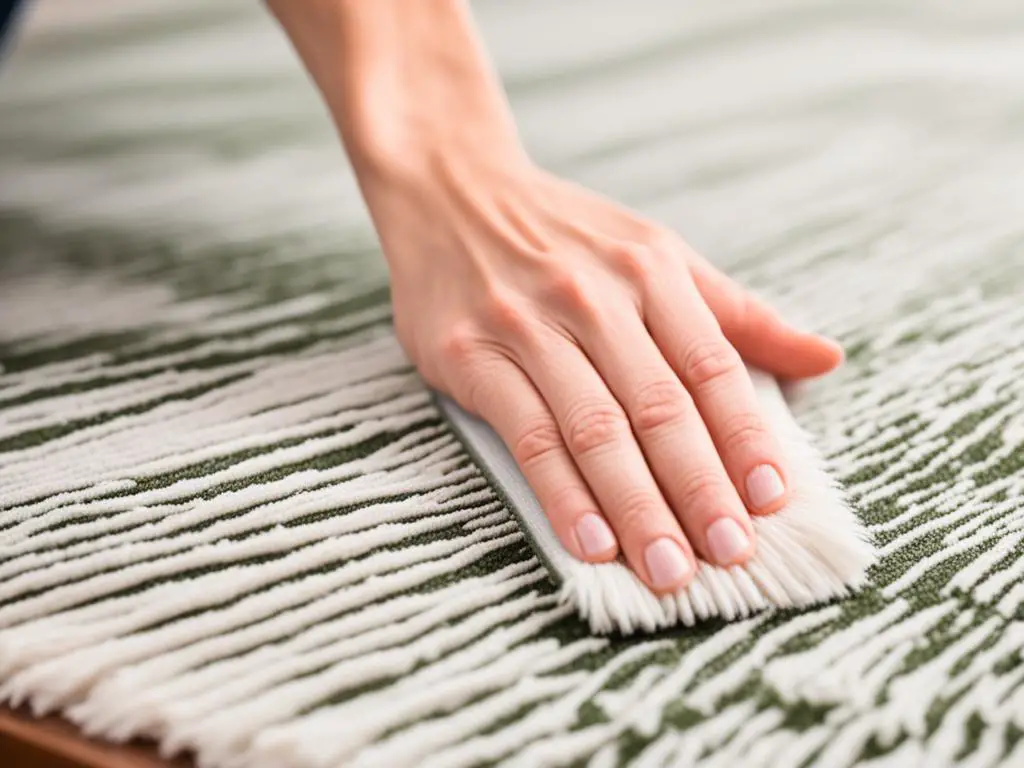
Expert Tip
When vacuuming your viscose rug, avoid using a beater bar or brush attachment as it can pull and damage the delicate fibers. Instead, use a suction-only or a gentle setting to protect the rug.
| Tip | Description |
|---|---|
| 1 | Regularly vacuum with a gentle setting or a non-electric vacuum |
| 2 | Avoid excessive moisture and high humidity |
| 3 | Rotate the rug every few months |
| 4 | Use furniture pads under heavy furniture |
Cleaning Other Types of Rugs
In addition to viscose rugs, there are other types of rugs that require specific cleaning techniques to maintain their beauty and extend their lifespan. Let’s explore the cleaning methods for wool rugs, silk rugs, and natural fiber rugs.
Cleaning Wool Rugs
Wool rugs are known for their durability and natural resistance to dirt and stains. To keep your wool rug in top condition, regular vacuuming is essential. Use a vacuum cleaner with a gentle setting to avoid damaging the fibers. Make sure to vacuum both sides of the rug to remove any trapped dirt and debris.
In addition to regular vacuuming, it is recommended to have your wool rug professionally cleaned by a reputable rug cleaning service at least once a year. Professional cleaning will help remove deep-seated dirt and rejuvenate the fibers, ensuring your wool rug remains fresh and vibrant for years to come.
Cleaning Silk Rugs
Silk rugs are delicate and require careful handling during cleaning. When vacuuming a silk rug, it’s important to use a vacuum cleaner with a gentle suction setting or a handheld vacuum. Avoid using a beater bar or rotating brush attachment, as this can damage the delicate silk fibers.
If a spill occurs on your silk rug, act quickly to prevent staining. Gently blot the area with a clean, white cloth or paper towel to absorb the moisture. Avoid rubbing the stain, as this may spread it further. If necessary, you can use a mixture of mild detergent and cold water to gently clean the stain. However, it’s always best to consult with a professional rug cleaner for the safest and most effective cleaning methods for silk rugs.
Cleaning Natural Fiber Rugs
Natural fiber rugs, such as jute, sisal, and seagrass, add a touch of organic beauty to any space. To keep these rugs clean, it’s important to regularly vacuum them using a brush attachment or a vacuum cleaner with a gentle setting. By removing loose dirt and debris, you can prevent the fibers from becoming embedded and causing premature wear.
Spot cleaning natural fiber rugs should be done with caution to avoid damaging the fibers. Use a mild soap or carpet cleaner specifically designed for natural fibers. Dilute the cleaner in water according to the manufacturer’s instructions and gently blot the stained area. It’s important to avoid oversaturating the rug with excessive moisture, as this can lead to mold or mildew growth.
Remember to always refer to the manufacturer’s care instructions for your specific rug type to ensure proper maintenance and cleaning.
Conclusion
Properly cleaning and maintaining a viscose rug is essential to preserve its beauty and durability. By following the tips and techniques outlined in this guide, you can ensure that your viscose rug remains in excellent condition for years to come.
To start, remember to spot clean stains promptly using approved solutions such as citric or acetic acid, white vinegar, mild dish soap, or a mixture of these with cold water. Always blot the stain instead of rubbing it. Applying the cleaning solution sparingly is crucial to avoid oversaturation and potential damage.
Avoid excessive moisture and high humidity, as these can lead to discoloration and fiber weakening. Regularly vacuuming your rug with a gentle setting or using a non-electric vacuum or carpet sweeper will help remove dirt and prevent beater wear. Additionally, rotating the rug every few months and using furniture pads to protect it from marks can distribute wear and maintain its appearance.
While you can handle spot cleaning on your own, professional deep cleaning is recommended every two or three years. Professional cleaners use dry-cleaning methods to prevent moisture damage. Avoid steam cleaning, as even light moisture can cause the fibers to become brittle and yellow.
With these guidelines, your viscose rug will remain a stunning accent in your home, providing comfort and style for years to come.
